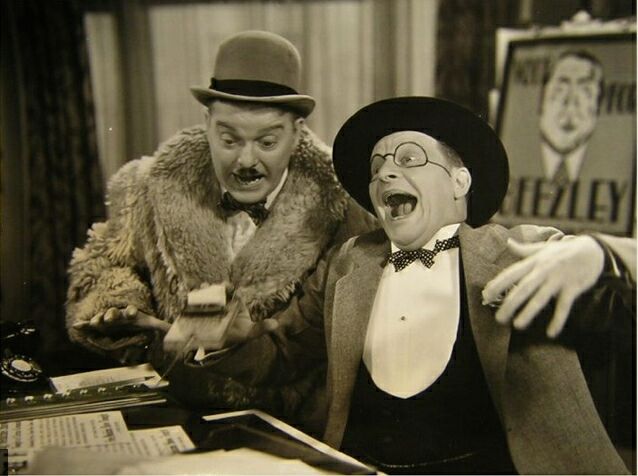Unless you are a die-hard aficionado of the films of the late 1920s and early 1930s, there is a good chance that you never heard of the comedy team of Bobby Clark and Paul McCullough. This duo worked their way up from the rough-and-tumble worlds of circus entertainment and vaudeville before reaching Broadway stardom in the mid-1920s. When Hollywood jettisoned the silent movies in favor of “talking pictures,” Clark and McCullough were among the many Broadway headliners to find their way to Hollywood.
In 1928 and 1929, Clark and McCullough starred in14 shorts produced by the Fox studio. Sadly, all but two of these films are considered lost: “Waltzing Around” (1929), which exists in private collections and is available for exhibition at the moment, and “The Belle of Samoa” (1929), which can be found in an unauthorized YouTube posting. (The team later made short films at RKO, but most of their work for that studio is not easily accessible for contemporary review.)
 The comedy of Clark and McCullough has been polarizing among many film scholars – some praise the duo for bringing a rough anarchy to the medium, while others bemoan the uneven distribution of comedy that favored Clark’s motor-mouthed antics while McCullough was often treated like a glorified onlooker to the mayhem. In some ways, the comics never truly found a comfortable transition from stage to screen, particularly Clark with his painted-on eyeglasses and his tendency to enunciate as if he was still playing to the last seat in the balcony. The theatricality of their act is clearly demonstrated in “The Belle of Samoa,” which is presented like a filmed record of a stage revue.
The comedy of Clark and McCullough has been polarizing among many film scholars – some praise the duo for bringing a rough anarchy to the medium, while others bemoan the uneven distribution of comedy that favored Clark’s motor-mouthed antics while McCullough was often treated like a glorified onlooker to the mayhem. In some ways, the comics never truly found a comfortable transition from stage to screen, particularly Clark with his painted-on eyeglasses and his tendency to enunciate as if he was still playing to the last seat in the balcony. The theatricality of their act is clearly demonstrated in “The Belle of Samoa,” which is presented like a filmed record of a stage revue.
The film opens with the duo walking on stage wearing funny clothing – Clark has a fez and oversized coat while McCullough wears a porkpie hat and plaid pants – and immediately announce that they are in Samoa. They knock on a door and are greeted by a large, somber man wearing greasepaint make-up and a wild wig – this was the 1929 Hollywood idea of a Samoan native. The man is the guard at a sacred temple of the maidens of Samoa, and he tells the interlopers, “Speak softly.” Clark takes the instruction with flippancy, announcing, “Oh, it is a speakeasy!”
After tricking the guard with a gambling distraction, Clark and McCullough race inside and they find the temple consists of young women who are wearing exotic garb that seems closer to an Arabian Nights fantasy than a Samoan village. “All of these flappers are looking for a man!” Clark exclaims before a Samoan princess (played by Lois Moran, a popular film star of the era who was transitioning into talkies). Clark feels that McCullough is crimping his style and whacks him in the chest with a cane, to which McCullough moans, “Oooooh, my operation!” Clark then explains McCullough to the princess by stating, “That’s my valet – he look like a hill, but he’s really a valet.”
Just when it feels like Clark is wearing out his welcome, a curtain passes across the stage to signal a change of scene. For the next several minutes, the audience is treated to an extended musical sequence starring Filoi and her army of 60 Samoan singers and dancers. After this interlude, Clark and McCullough return to face death by beheading for defiling the maidens’ temple. The princess begs her father to spare the duo, and their salvation is rewarded by the princess performing a decidedly non-Samoan pop ditty while backed with her own small army of singers and dancers. At the end, everyone runs out on stage to take a bow.
Admittedly, “The Belle of Samoa” is no one’s idea of a classic. But it offers an idea of what Clark and McCullough’s Broadway offerings of that distant era may have looked like. Yes, the comedy is too corny and too politically incorrect for today’s tastes, but it moves with a rapid speed and a heavy sense of self-confidence that compensates for whatever it is missing in the aesthetics department. Clark muffs two lines, but recovers quickly and keeps firing away with his material. McCullough, however, is the real joy – he watches the proceedings with a slacker’s bemusement, and his cackle-voice delivery gives an odd charm to whatever he says. And while the Samoan musical segment requires a bit of patience, Lois Moran’s solo is fun and sexy – and it is a shame that she left films a few years after “The Belle of Samoa,” as she clearly possessed a star power that warranted a longer screen presence.
“The Belle of Samoa” is a hoary and somewhat creaky affair, but it is valuable as a reminder of where American comedy came from.




